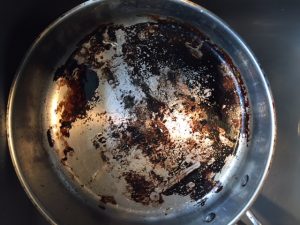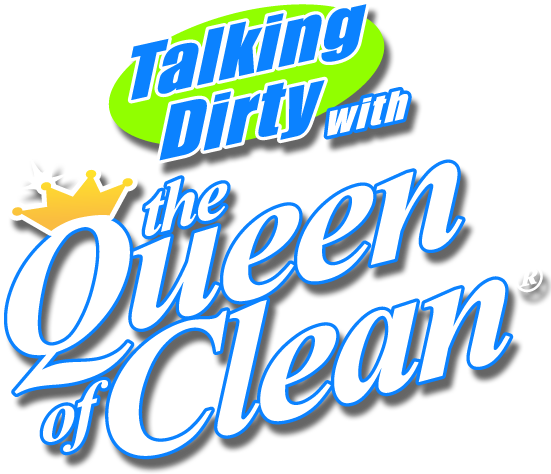CLEANING TIP SEARCH
Find your cleaning solution below
HELP! HOW DO I CLEAN MY COOKWARE –WHAT IF I BURN SOMETHING IN IT! – VIDEO
HELP! HOW DO I CLEAN MY COOKWARE –WHAT IF I BURN SOMETHING IN IT! – Aired on 3TV / Good Morning Arizona – Monday, April 23, 2018 – 8:40am (Video below, bottom of this page)
CARING FOR STAINLESS STEEL COOKWARE

Only salt water once it’s come to a boil. When water is salted pre-boil, “pitting corrosion” can occur, which leaves tiny but irreparable pockmarks. Salt water for things like pasta only after the water is boiling.
Allow the pan to cool completely before washing it. Submerging or soaking a hot stainless steel pan in cold water might cause irreparable warping.
Only use non-abrasive cleaners and sponges. Coarse scrubbers and harsh cleaning solutions like bleach or household cleaners can scratch your stainless steel and damage its finish.
How to clean Problem Areas:
For cleaning chalky white spots (which can result from calcium buildup in the water): Bring a solution of 1 part white vinegar to 3 parts water to a boil in the pan, let it cool, and then wash and dry as normal.
For stuck food bits: Scrub the pot with a non-abrasive sponge to get off any food bits you can, then fill the pot or pan with enough soapy water to cover the food, bring to a boil, and scrape (the food should come away easily).
For discoloration (often rainbow in appearance), which can occur from overheating: Try washing your pan with vinegar or using the pot to cook a high-acid food, like tomato sauce.
For hard-to-clean burnt or burnished pans: Use Barkeeper’s Friend Cleanser: Pour a small amount of water in the pan or pot, add a few shakes of B.K.F., and create a paste or slurry by mixing the two together. Scrub with a non-abrasive sponge to remove the stains. Buy Barkeepers at grocery, big box stores and home centers. It is good for glass cooktops, sinks, bathrooms, etc.
The MY PAN IS RUINED solution:
Oven cleaner. This is for pans that you have tried everything else on. Lay a cold stainless steel pan on newspapers outside. Spray with oven cleaner and let sit 30 minutes or so. Wearing rubber gloves, scrub with a scrubber. Repeat if needed.
Once the pan is clean, wash thoroughly and dry.
CARING FOR THE NEW COPPER COOKWARE
What to do when the pan is new before you use it.
Season the pan.
Heat the clean dry pan on low heat for about 30 seconds.
Remove from the heat and add 1 tablespoon of vegetable oil.
Using a paper towel, rub the oil all over the pan.
Repeat each time if you wash the cookware in the dishwasher.
The big NO!
Don’t use aerosol cooking sprays. These sprays will build up on cookware and become difficult to remove and also reduce the non-stick coating release.
Regular cleaning
Allow pans to cool before cleaning or filling with water. After each use fill the pan with hot water and a couple of squirts of liquid dish soap. Let this stand until lukewarm. Use a sponge or soft cloth to remove any remaining food particles. DO NOT use steel wool or other metallic pads. Rinse and dry thoroughly.
Remove stubborn residue:
If food is burned, black residue may remain. To remove it add about 1 inch of water to the pan and a tablespoon of NON-LEMON dishwasher detergent. Bring to a boil, reduce heat and simmer 15 minutes. Let pan cool, then drain and rinse. Wash using a sponge and rinse and dry.
CARING FOR CAST IRON COOKWARE
First let me say that if you don’t have cast iron you don’t need detailed instructions. While I will cover this quickly for TV, if you go to my BLOG at Queenofclean.com I have a printable, in-depth write up on caring for cast iron to make it a family treasure.
Clean the skillet immediately after use, while it is still hot or warm. Avoid soaking the pan or leaving it in the sink or it may rust.
Wash the skillet by hand using hot water and a sponge or stiff brush. Avoid using the dishwasher, soap, or steel wool, as these may strip the pan’s seasoning.
To remove stuck-on food, scrub the pan with a paste of coarse kosher salt and water. Stubborn food residue may also be loosened by boiling water in the pan.
Thoroughly towel dry the skillet or dry it on the stove over low heat.
Using a cloth or paper towel, apply a light coat of vegetable oil or melted shortening to the inside of the skillet. Some people also like to oil the outside of the skillet. Buff to remove any excess. Store the skillet in a dry place.
CARING FOR NON-STICK PANS
Normal Cleaning
Be sure the pan is cool.
Wash and dry the pan with warm soap water, rinse and dry well. If you stack your pans, place a paper plate between them to keep them from scratching and damaging each other.
Removing Grease from Inside the Pan
If there is a layer of oil that is difficult to remove, fill the pan with water and add ½ cup of vinegar.
Bring the water/vinegar mixture to a boil. As the mixture boils, the oil layer will rise to the top.
Remove the oil and dispose of the water.
Wash the pan with warm water and soap using a nylon scrubber. Rinse completely and dry with a soft cloth.
Removing Residue from Non-Stick Pans
Any tough residue that is on the inside or outside of the pan can be removed using this method.
Sprays and grease can leave a residue on non-stick pans that is difficult to remove.
Start by mixing water and baking soda to make a paste.
Spread the paste on the residue.
Scrub the surface with a nylon scrubber. The baking soda acts as an abrasive to safely remove the residue without damaging the non-stick surface.
Once the residue is removed, wash with soap and water.
Rinse completely before drying with a soft cloth.
Tips
Non-stick pans are designed to be used without oil.
Avoid using cooking sprays, they can leave a residue that is difficult to remove.
Avoid harsh cleaners or abrasive scrubbers. They can damage the pan surface.
If you are unable to wash a cooled pan right away, fill it with water to keep the residue from drying before you can wash it out.
Watch the actual 3TV broadcast here:

